General tips
Begin summer watering using drip irrigation, if possible. Otherwise, water early in the day to minimize evaporation and allow leaves to dry before nightfall.
Water deeply but infrequently to encourage roots to go deeper. To conserve moisture, add 2-3 inches of mulch to your garden beds and around trees and shrubs. Containers and hanging baskets may need water daily.
Patrol for slugs and aphids. Encourage birds in garden areas for help with insect control. Remember, if you kill a beneficial insect, you inherit its work.
Enjoy June colors and scents.
Flowers
Plant annuals. Deadhead faded flowers. Stake plants that get top-heavy.
Trim back perennials after blooming. Remove foliage from spring-flowering bulbs after they have died back.
Divide spring-flowering bulbs and replant or store until fall. Continue to plant dahlias, begonias and gladioli. Deadhead roses and fertilize.
Check roses for mildew and black spot; remove and discard affected leaves; do not compost diseased plant parts.
Pinch back chrysanthemums about ½-inch when new growth reaches 6 inches for bushier plants and more blossoms; do not pinch them back after the Fourth of July.
Plant fall-blooming perennials and bulbs such as Star of Bethlehem, asters, chrysanthemums, autumn crocus and hardy cyclamen.
Shrubs
It is best to plant shrubs in early spring or in fall. If you plant now, take care to provide sufficient water throughout the summer.
Trees
Fertilize young trees with slow-release fertilizer and water regularly and deeply. Prune Japanese maples, removing dead branches and thinning lightly. Watch for tent caterpillars; strip or prune out and destroy nests and caterpillars as soon as noticed. Wait until fall to plant trees.
Fruit trees
Thin fruit. (See sidebar) Watch for signs of brown rot, scab and powdery mildew; treat with a fungicide according to the product label.
Berries
Watch for gray mold on strawberries; immediately remove and discard affected berries and leaves. Fertilize blueberry bushes with 1-2 ounces of ammonium sulfate (once this month) or 1 Tablespoon of fish emulsion diluted in 1 cup water (twice this month). Berries need one inch of water each week.
Vegetables
Transplant herbs and warm-season vegetable starts including basil, tomatoes, cucumbers, squash and corn. Place basil and tomatoes in the warmest spot with full sun exposure; cover when night temperatures fall below 50 degrees. Avoid diseases by spacing tomatoes properly and support plants using stakes, cages or trellises for good air circulation. Sow lettuces, spinach, kale, chard and cabbage. Replant replacement crops when early lettuce, mustard greens, bok choy and spinach mature. Control weeds with frequent cultivation. Provide an inch of water per week as rains taper off.
Stop harvesting asparagus when spears become smaller than a pencil; fertilize and allow tops to grow. Harvest no more than half of rhubarb stalks so remaining leaves can sustain the crown. Stop harvesting when plant begins to produce slender stalks.
Watch for leaf miners on beets, chard and spinach; remove and discard infested leaves. Handpick and discard caterpillars found on leaves.
Lawns
If not letting the lawn go dormant over summer, water deeply at least twice a month and fertilize once during the last half of the month. Keep irrigation systems on manual, not timed, application. Mow often enough to remove only one-third of grass blade length. Continue “grass cycling,” leaving clippings on lawn. Aerating in early summer can damage new growth.
Kamera Muralt and Bill Wrobel are WSU-certified Clallam County Master Gardeners.


